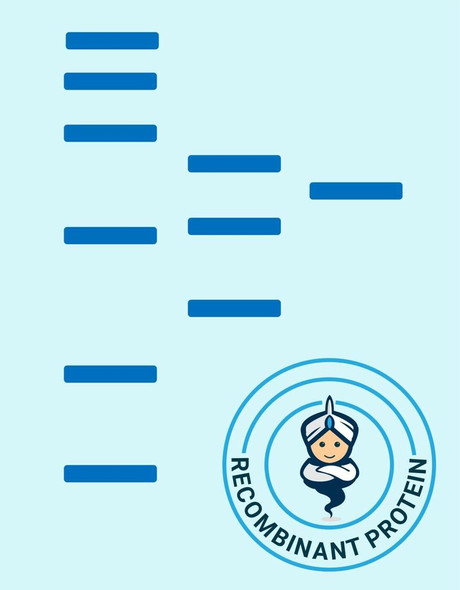Description
| Product Name: | Human RGN Recombinant Protein |
| Product Code: | RPPB4446 |
| Size: | 20µg |
| Species: | Human |
| Target: | RGN |
| Synonyms: | Regucalcin, RC, Gluconolactonase, GNL, Senescence marker protein 30, SMP-30, RGN, SMP30. |
| Source: | Escherichia Coli |
| Physical Appearance: | Sterile filtered colorless solution. |
| Formulation: | RGN protein solution (0.5mg/ml) containing 20mM Tris-HCl, pH8.0, 2M Urea and 20% Glycerol. |
| Stability: | Store at 4°C if entire vial will be used within 2-4 weeks. Store, frozen at -20°C for longer periods of time. For long term storage it is recommended to add a carrier protein (0.1% HSA or BSA).Avoid multiple freeze-thaw cycles. |
| Purity: | Greater than 85.0% as determined by SDS-PAGE. |
| Amino Acid Sequence: | MGSSHHHHHH SSGLVPRGSH MSSIKIECVL PENCRCGESP VWEEVSNSLL FVDIPAKKVC RWDSFTKQVQ RVTMDAPVSS VALRQSGGYV ATIGTKFCAL NWKEQSAVVL ATVDNDKKNN RFNDGKVDPA GRYFAGTMAE ETAPAVLERH QGALYSLFPD HHVKKYFDQV DISNGLDWSL DHKIFYYIDS LSYSVDAFDY DLQTGQISNR RSVYKLEKEE QIPDGMCIDA EGKLWVACYN GGRVIRLDPV TGKRLQTVKL PVDKTTSCCF GGKNYSEMYV TCARDGMDPE GLLRQPEAGG IFKITGLGVK GIAPYSYAG |
Regucalcin (RGN) is a member of the SMP-30/CGR1 family. Regucalcin is a Ca (2+)-binding protein which does not contain EF-hand motif of Ca (2+)-binding domain. RGN has a critical role in the keep of intracellular Ca2+ homeostasis due to activating of Ca2+ pump enzymes in the plasma membrane (basolateral membrane), microsomes (endoplasmic reticulum) and mitochondria of many cells. Moreover, RGN plays a multifunctional role in the regulation of cell functions in the liver, kidney cortex, heart and brain and a suppressor protein for cell signaling systems in many cell types.
RGN Human Recombinant produced in E.Coli is a single, non-glycosylated polypeptide chain containing 319 amino acids (1-299 a.a.) and having a molecular mass of 35.4kDa.RGN is fused to a 20 amino acid His-tag at N-terminus & purified by proprietary chromatographic techniques.
| UniProt Protein Function: | RGN: Gluconolactonase with low activity towards other sugar lactones, including gulonolactone and galactonolactone. Can also hydrolyze diisopropyl phosphorofluoridate and phenylacetate (in vitro). Calcium-binding protein. Modulates Ca(2+) signaling, and Ca(2+)-dependent cellular processes and enzyme activities. Belongs to the SMP-30/CGR1 family. 2 isoforms of the human protein are produced by alternative splicing. |
| UniProt Protein Details: | Protein type:EC 3.1.1.17 Chromosomal Location of Human Ortholog: Xp11.3 Cellular Component: nucleoplasm; cytoplasm; nucleus Molecular Function:zinc ion binding; gluconolactonase activity; calcium ion binding; enzyme regulator activity Biological Process: cellular calcium ion homeostasis; L-ascorbic acid biosynthetic process; positive regulation of ATPase activity; regulation of calcium-mediated signaling |
| NCBI Summary: | The protein encoded by this gene is a highly conserved, calcium-binding protein, that is preferentially expressed in the liver and kidney. It may have an important role in calcium homeostasis. Studies in rat indicate that this protein may also play a role in aging, as it shows age-associated down-regulation. This gene is part of a gene cluster on chromosome Xp11.3-Xp11.23. Alternative splicing results in multiple transcript variants. [provided by RefSeq, Sep 2013] |
| UniProt Code: | Q15493 |
| NCBI GenInfo Identifier: | 3334328 |
| NCBI Gene ID: | 9104 |
| NCBI Accession: | Q15493.1 |
| UniProt Related Accession: | Q15493 |
| Molecular Weight: | 33 kDa |
| NCBI Full Name: | Regucalcin |
| NCBI Synonym Full Names: | regucalcin |
| NCBI Official Symbol: | RGN�� |
| NCBI Official Synonym Symbols: | RC; GNL; SMP30; HEL-S-41�� |
| NCBI Protein Information: | regucalcin |
| UniProt Protein Name: | Regucalcin |
| UniProt Synonym Protein Names: | Gluconolactonase (EC:3.1.1.17); GNL; Senescence marker protein 30; SMP-30 |
| Protein Family: | Regucalcin |
| UniProt Gene Name: | RGN�� |
| UniProt Entry Name: | RGN_HUMAN |






